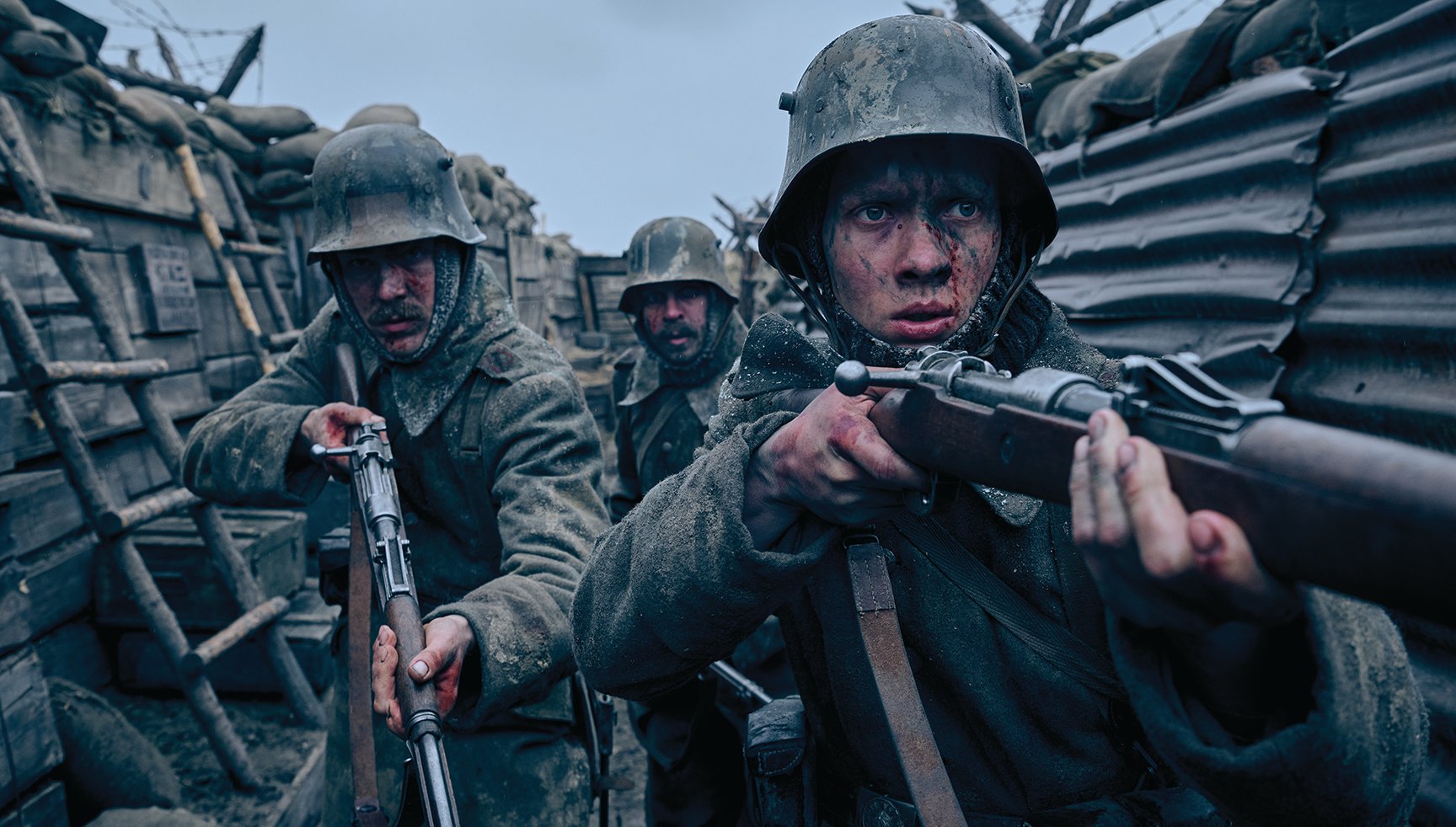
Back to the Battlefield for All Quiet on the Western Front
James Friend ASC, BSC and director Edward Berger immerse the audience in the action.
Unit photography by Reiner Bajo. All images courtesy of Netflix.
Director Edward Berger was determined to give the World War I epic All Quiet on the Western Front a new interpretation — and the Russian invasion of Ukraine, which has brought war to Europe again, has thrown his sentiment into sharp relief. All Quiet is “a German story that had to be told from a German perspective — the perspective of terror, guilt, shame, horror and pain,” says Berger, who also served as producer and co-writer. “Germany has an unfortunate legacy of expertise in that, [and the Russo-Ukrainian War] is going on right now. We can share these stories with the world and learn from each other. This story just never gets old.”
A German production team mounted the new adaptation of the narrative — which is based upon Erich Maria Remarque’s 1929 novel that spawned the 1930 Academy Award-winning feature directed by Lewis Milestone and shot by Arthur Edeson, ASC, and the 1979 TV movie directed by Delbert Mann and shot by John Coquillon, BSC. This new feature for Netflix follows German teen Paul Bäumer (Felix Kammerer) and his classmates as they are swept up in a tide of nationalism and galvanized by their teacher to enlist and fight for their country, only to be met with disillusionment and death.
Larger Tapestry
Berger tapped British director of photography James Friend, ASC, BSC to help craft the film’s look after the two collaborated on the miniseries Patrick Melrose and the series Your Honor. “James is incredibly talented and knowledgeable,” the director says. “He’s such a movie geek.” He adds that Friend likes to explore “how to use the camera to create what the characters feel, and visualize what’s in their ‘stomachs.’ We sit for weeks on end and talk about shots and break-down scenes. I’ve learned from him. He’s my most important collaborator.”
Friend notes that although he was deeply affected by the landmark 1930 film, and vividly remembers its “snapshots and iconic imagery,” he resisted relying on it as a visual reference. “It’s not something I wanted to draw upon,” he says. “We have a few gentle nods to the original, but we didn’t want to be influenced by it in any way. The first thing I did was read the book multiple times and immerse myself in that. Then I studied photography in the trenches from that time, to help me visualize the book and the soldiers’ conditions, and details such as costumes.”
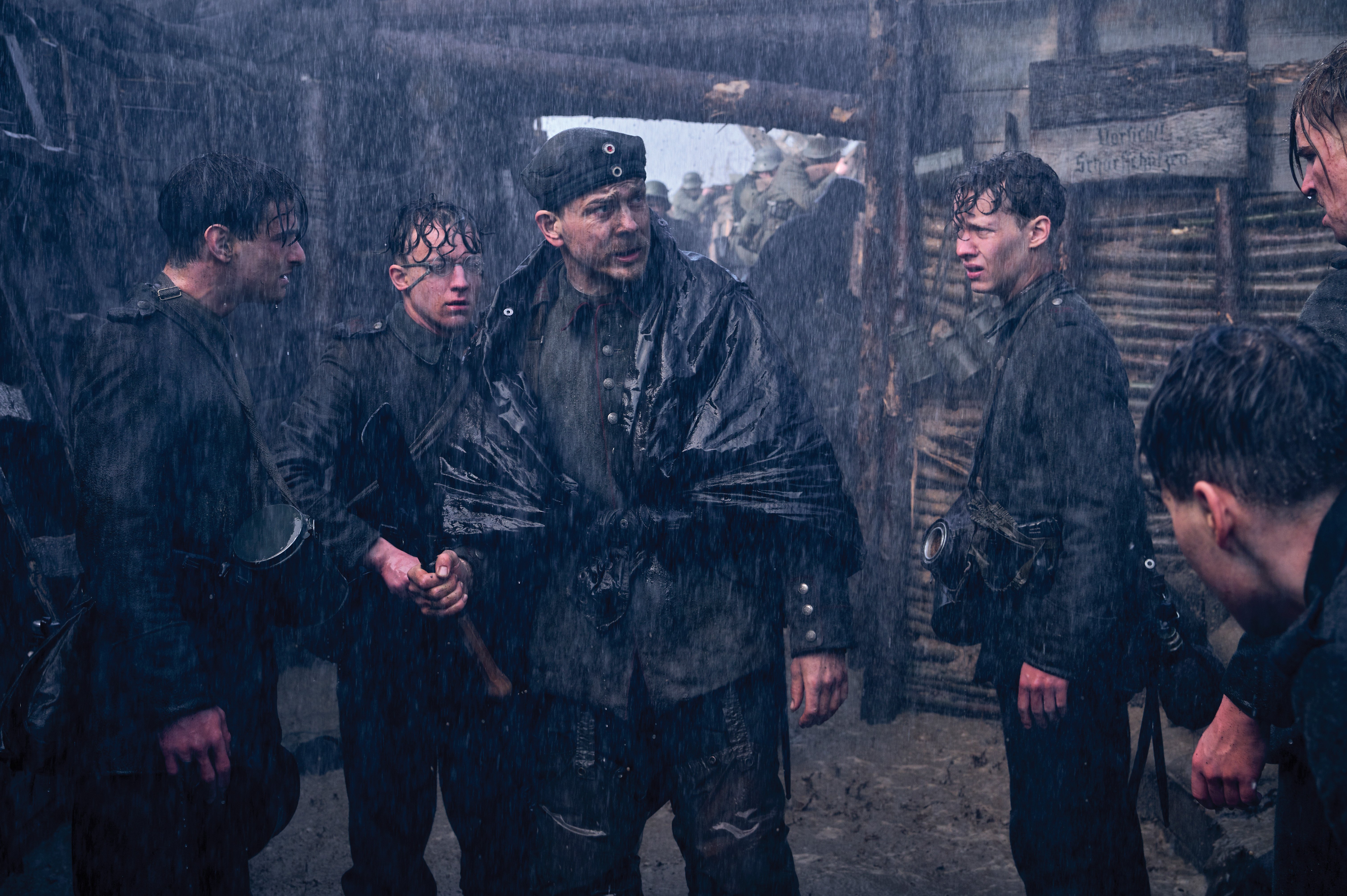
Friend did, however, find inspiration in a rich tradition of war films: the Soviet World War II drama Come and See, which he admires “for its realism, harrowing nature, and its approach to photography and palette”; Apocalypse Now, which he calls “one of my favorite movies and a big visual influence”; Gallipoli, another “movie I adore”; Paths of Glory, Stanley Kubrick’s classic World War I tale; and the Peter Jackson-helmed documentary They Shall Not Grow Old. He adds that above all else, “I wanted to look at the larger tapestry of the historical landscape, and also give the audience the feeling that we’re in Paul’s shoes — going through it with this kid and what he experiences.”
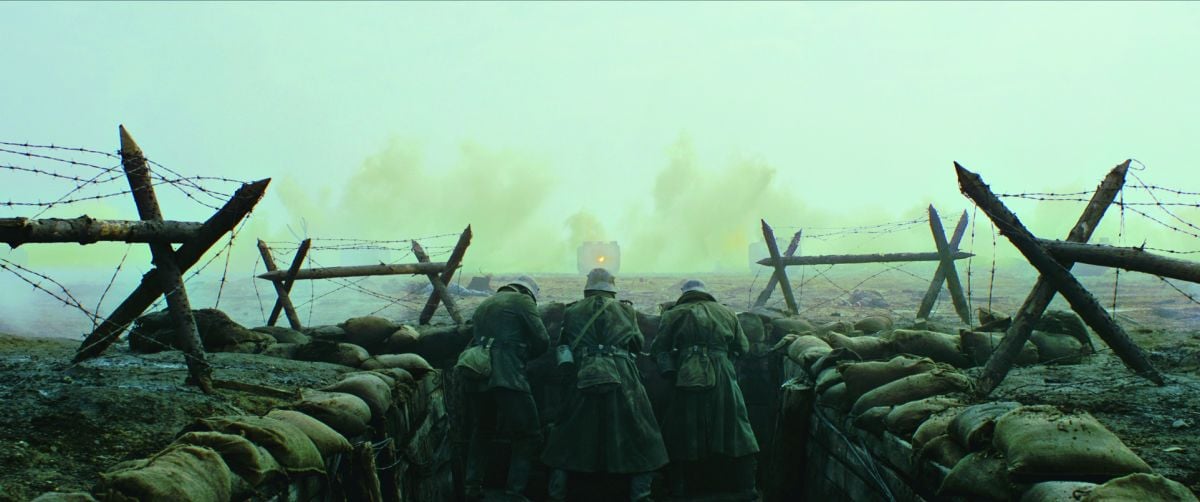
Coloring Carnage
One way the film places viewers up close to its fraught battle scenes is through its varied color palette. “The soldiers’ uniforms were designed to be camouflaged and blend in,” he says. “So, we would find any excuse to add a pop of color.” For example, when Paul and his comrades find themselves under attack from a tank division, the vehicles appear from behind a dramatic cloud of yellow smoke.
“I don’t know if that color is historically correct,” Friend says. “It was dreamt up in a hotel suite between Ed and me as we did visual notes and thought, ‘What horrible, acrid color can we introduce that will pop?’ We didn’t want the film to have that desaturated, almost black-and-white ‘war movie’ feel that has been visually exhausted.”
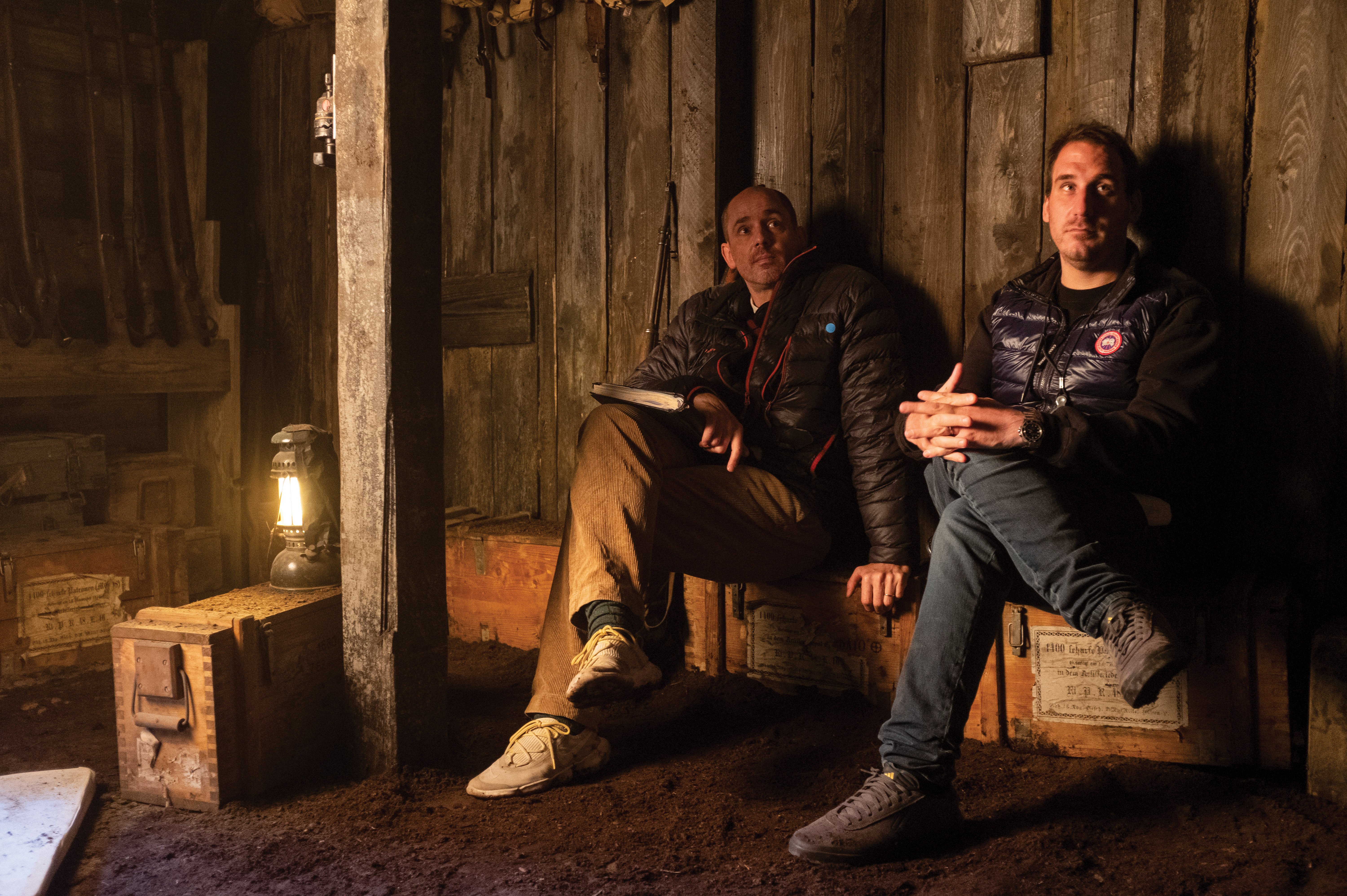
Battle-Testing Cameras
The filmmakers stuck to their meticulously designed storyboards as much as possible. On such a large-scale film, featuring battle scenes with up to 400 extras, one might expect them to have run three or more cameras — but they attest it was mostly a one-camera show.
“There was no compromise from Edward. He would always go for the best frame, even in the harshest shooting environment,” says A-camera/ Steadicam operator Danny Bishop — a member of the Association of Camera Operators and the Society of Camera Operators, and a BSC associate member.
Before choosing the cameras that would optimally capture the scope and detail of the production, Friend says they “tested pretty much everything, but I knew in my heart what we wanted to achieve and how we were going to achieve it — and the [Arri Rental] Alexa 65 instinctually felt right. The larger-format sensor seemed the correct grammar for the film: framing for Paul and his comrades and allowing them to move throughout a wider frame, but still keeping things engaging for the audience. And you have all the beauty of slightly longer lenses, with the field of view of wider glass.”
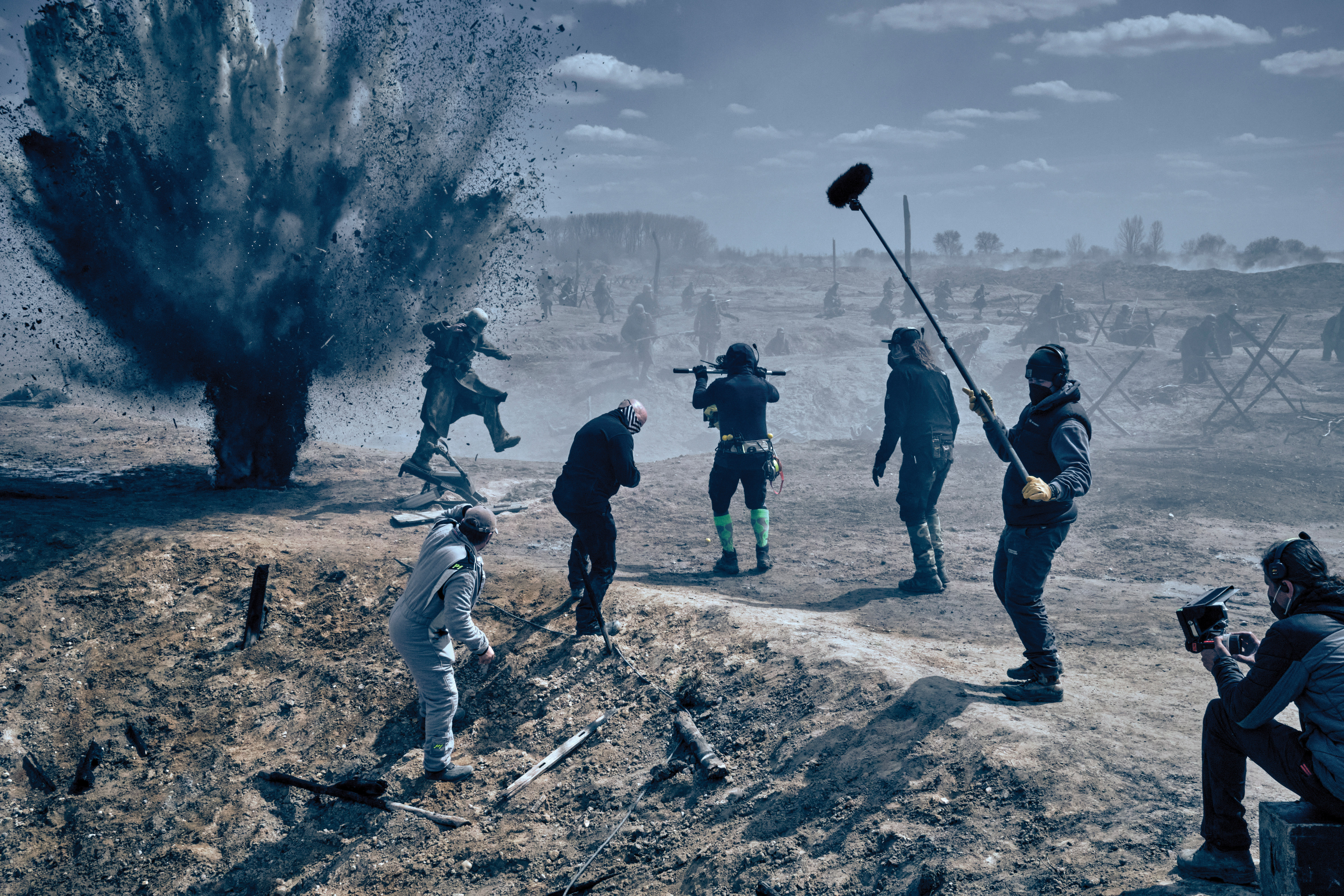
After testing, Friend and Bishop concluded that they would employ the Alexa 65 as their primary camera and Arri’s Alexa Mini LF, with its smaller form factor, for many of the battle sequences. “I learned that the Alexa 65 and the Mini LF go hand-in-hand beautifully,” Friend says. “We would have an establishing shot on the 65, then go into the Mini LF, and no one would notice any difference. In the DI suite, even I sometimes couldn’t remember what was shot on the 65.”
Vast Terrain, Cramped Train
For the battle sequence in which the Germans attack the French trenches at sunrise, the crew had run of the immense, abandoned, Soviet-era Milovice air base, located in the Czech Republic, where they constructed trenches for both sides in the conflict, separated by about 300 meters of no-man’s land. They built three paths that provided more solid footing for Bishop and the grips amid the surrounding muddy terrain.
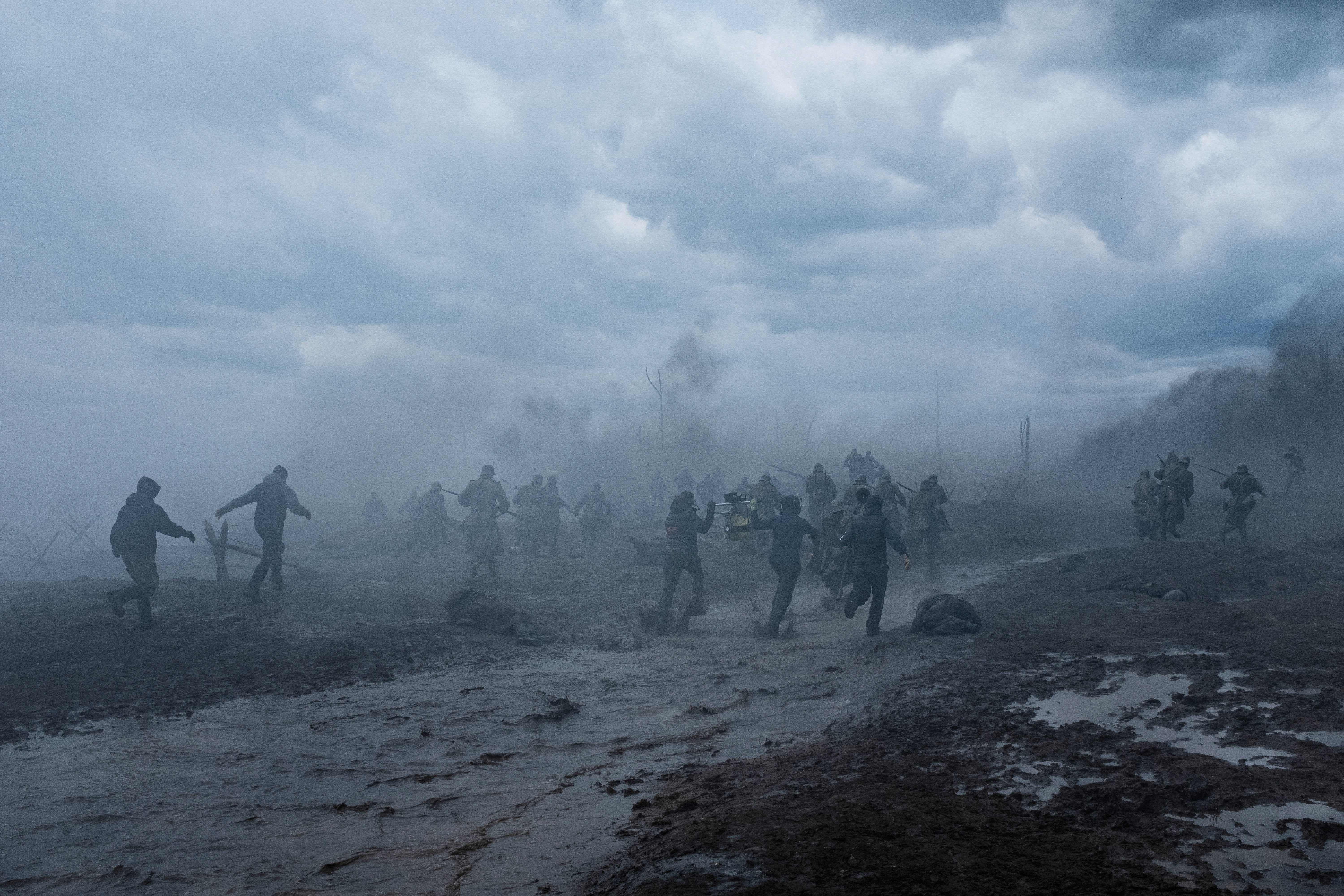
Berger says he often likes the camera to be rock solid on a tripod or dolly, but various other tools were employed to execute camera movement. “We [shot] handheld in certain moments and used the Steadicam where necessary,” the director adds. “But on the battlefield, it was hardly possible for Danny to walk or run with a Steadicam. The terrain would have been impossible to maneuver. So, the Stabileye [handheld gyrostabilizer] became the right piece of equipment for that. We couldn’t have gotten what we did without it.”
The camera mounted to the stabilized head was used in multiple configurations with Bishop and Friend operating remotely. “There’s a scene at the beginning of the film where the camera moves through a trench, which was done with one grip holding it,” Friend recalls. “And for when our hero climbs out of the trench, we mounted the Stabileye to a Technocrane, lifted it up out of the trench with him, then disconnected it from the crane and handed it to two more grips who would continue on foot and run across the battlefield with it [in one continuous shot]. It was [also] sometimes as rudimentary as someone holding a bar with the Stabileye.”
Scenes that take place inside a train were shot at the nearby Barrandov Studios in Prague, with the set constructed between two LED walls. “Everyone associates the 65 with big landscape photography,” Friend says, “but we shot everything in the confined space in the train on the 65, moving it through the space — all off of a dolly and GFM [Grip Factory Munich] jib arm —and that’s where the camera really came to life. It was a more immersive way of telling the story.”
Mixing Glass
The production was captured in LF Open Gate 4.5K format with spherical lenses, but cropped to a final aspect ratio of 2.39:1. “I like to give as much around the frame as possible if we need to reframe things,” Friend says. “We looked at large-format anamorphic lenses, but I was concerned about the action work on the battlefield. It looked glorious, but the weight of the lenses with the dynamic camera moves and shooting stop in low light was a major consideration. So, spherical was the right decision.”
Friend notes that seeing the eclectic lens list applied to Joker by Lawrence Sher, ASC gave him the confidence to shake things up. “He shot on a huge variety of lenses, and that was one of the greatest-looking movies of the last decade,” the cinematographer says. “His lens choices felt true to the story. He delivered perfectly, and for me it was a revelation. Lenses pave the groundwork for the visuals and allow for you to mix and match.”
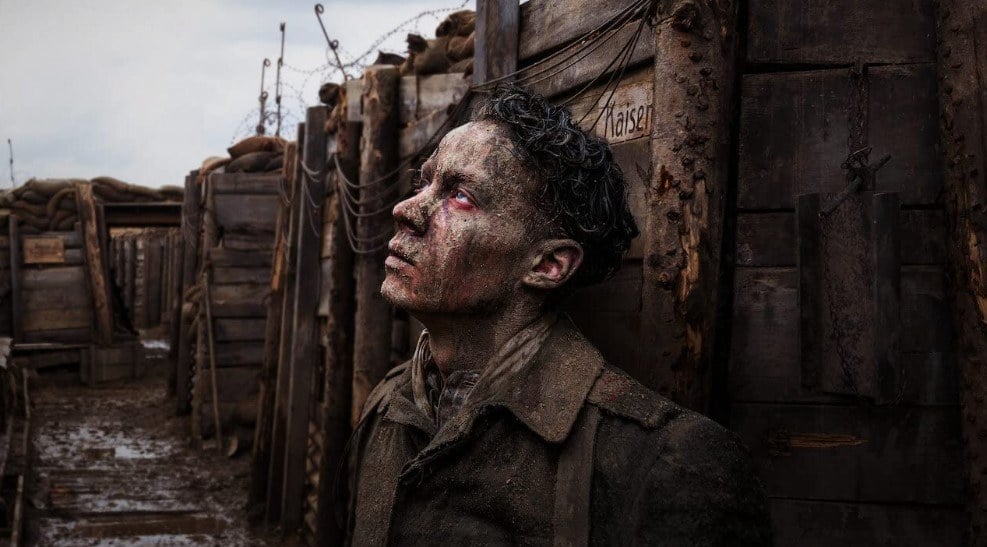
For most exteriors shot on the Alexa 65, Friend used slightly detuned Arri Rental Prime DNA lenses. The cinematographer notes that for some interiors, particularly those with backlit windows, the DNAs flared a bit more than he wanted for the look he was aiming for, so he switched to his own set of Tribe7 Blackwing7 lenses. For a wider option, Arri supplied a Zeiss Compact Prime CP.2 21mm T2.9. “They detuned it slightly, softening it, and it worked beautifully on the Mini LF,” Friend says. He adds that the primary lenses for the Mini LF were the 28mm and 35mm Prime DNAs and the 37mm Blackwing7.
For early scenes set at Paul’s school — also shot on the Alexa 65 — such as when the students crowd a stairway as their teacher delivers a rousing speech from the landing above, the filmmakers turned to Arri Rental Prime 65 S glass. Friend explains that the DNAs and Blackwing7s behaved unpredictably in high-contrast situations due to the detuning, and the flares could be overwhelming. “The Prime 65 S lenses have a soft, classical look,” Friend says. “They felt a little bit warmer, crisper and more optimistic.”
The filmmakers almost always favored the wide end of the spectrum — keeping Paul’s journey in the front of their minds, per their overarching aim. “The camera is with him nearly all the time,” Friend explains. “We needed wider lenses as we moved the camera through the space to represent his point of view.”
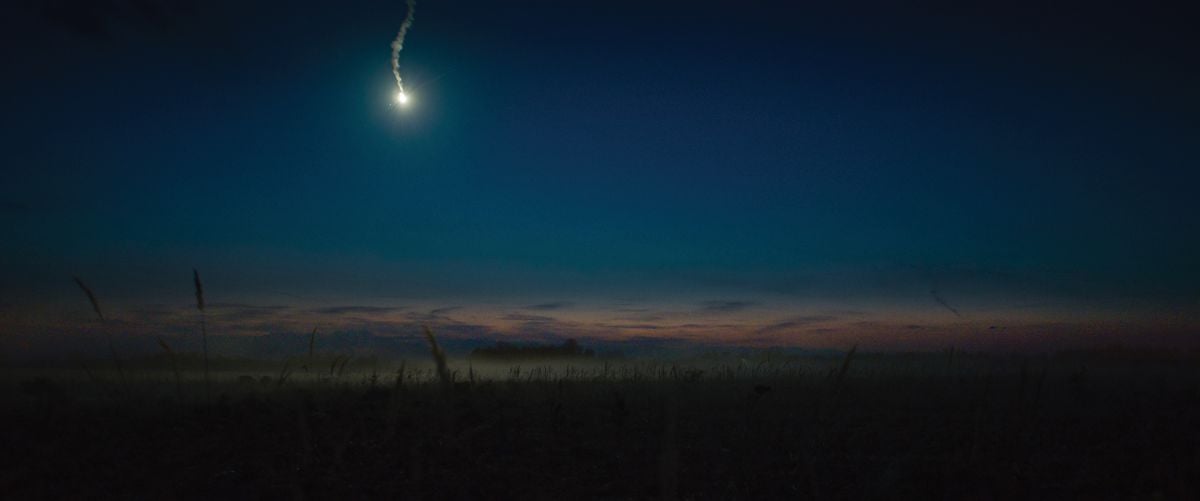
Fire in the Sky
Particularly challenging nighttime exteriors included a scene in which Paul and his friend Albert (Aaron Hilmer) are on guard duty at the front and ill-advisedly fire on an unidentified moving object in no-man’s land. For this sequence — in which military flares are seen in the night sky — Friend employed Sony’s Venice camera, using the Rialto system and shooting at 2,500 ISO. “I wanted interactive lighting from the flares,” Friend says. “And as sensitive as the Alexa sensor is, we needed just a little bit more from the dual native ISO of the Venice.”
The flares, descending slowly on parachutes, provided an orange glow on the battlefield, which was supplemented by fog and 18K Arrimax fixtures behind 12'x12' Half Grid on condors to the left and right of the battlefield. Friend describes the effect as “lovely rays of light going through the trees and all the settings and props.”
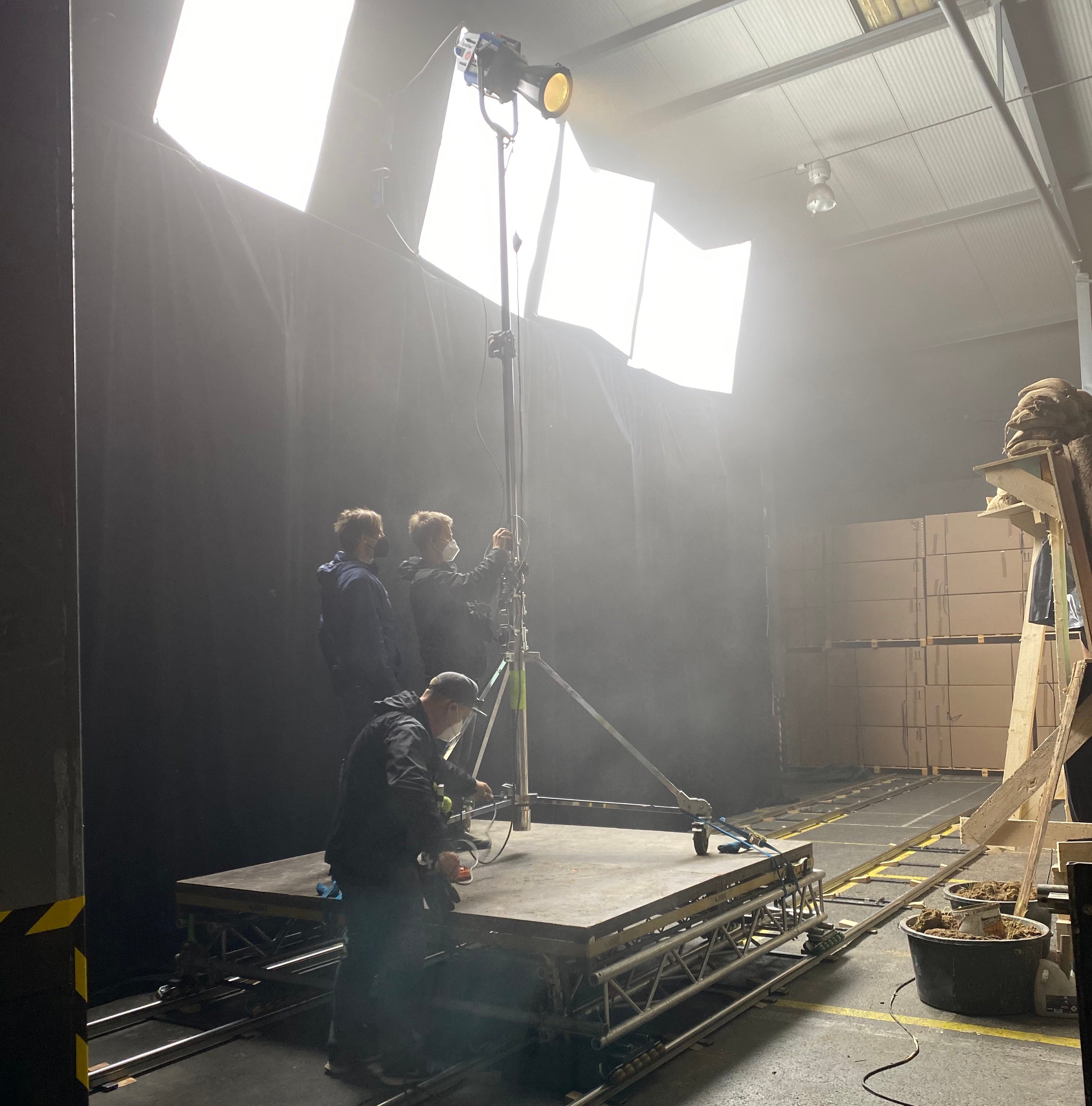
Gaffer Daniel Kafka also procured a then-new Arri Orbiter LED unit, which proved useful for its ability to read and match ambient light. The crew would fire a test flare and the Orbiter would read its light intensity, color and flicker, recording it to a lighting console operated by Petr Sita.
In addition, the crew built a massive 60'x60'x40' softbox, containing approximately 30 Arri SkyPanels wrapped in Full Grid and suspended from a large crane. The flare’s color and flicker qualities, recorded by the Orbiter, were sent from the console to the softbox, which replicated those characteristics and allowed the crew to control the intensity.
With this system in place, when a flare was on-camera, it was a practical source illuminating the shot, with the Arrimaxes backlighting the smoke for visual separation. Then, when the scene cuts to a view of the actors, they were lit by the soft box emulating the light of the flare.
For this night exterior, the Orbiter was used exclusively for its ability to read and record the flare’s light properties. However, Friend notes that the fixture was used for illumination as well — in particular, when mounted to a dolly to light “an interior bunker scene, as an effect to simulate the flare’s movement across the night sky.”
Against the Gleam
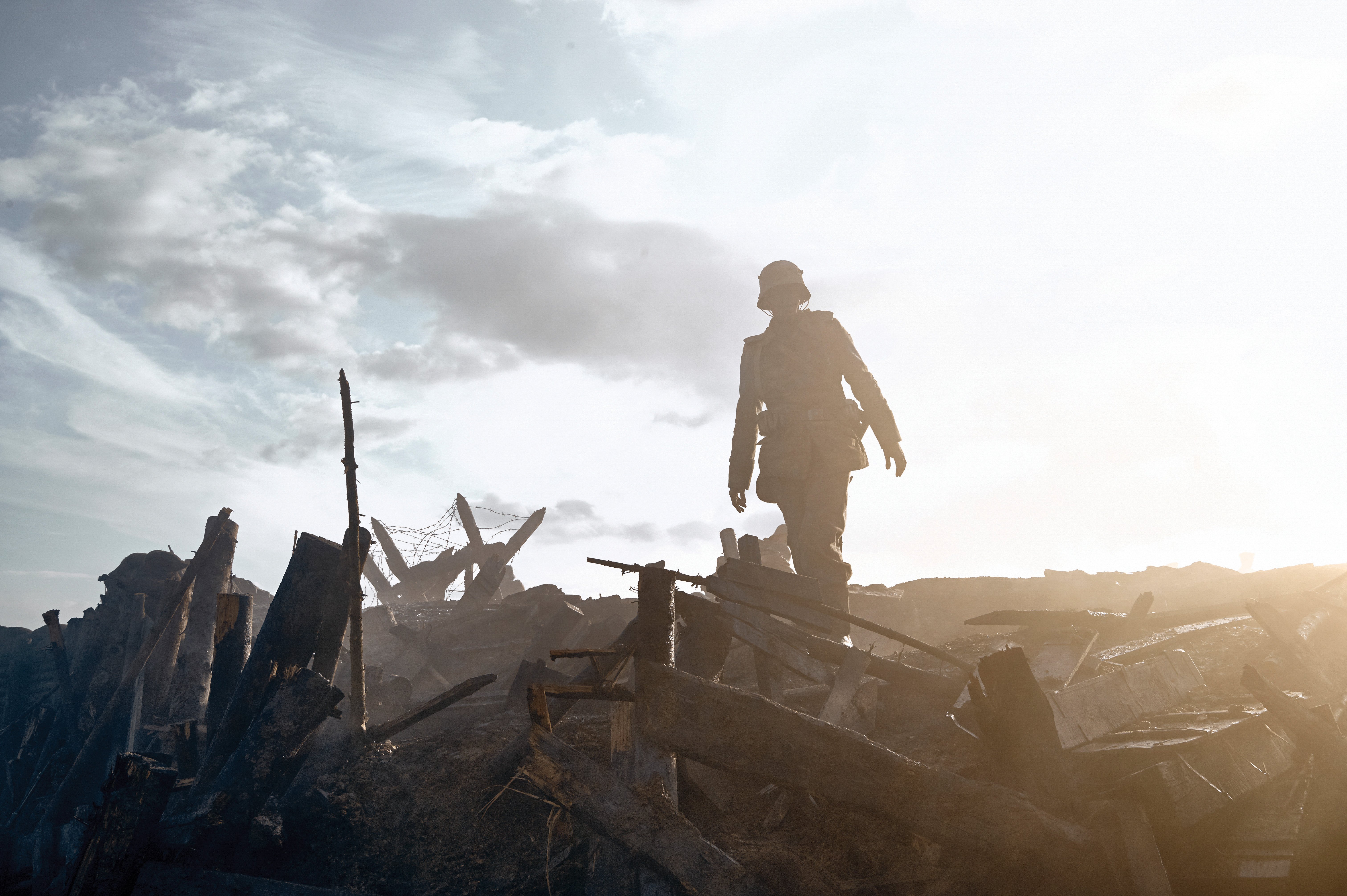
For daytime battle scenes, extreme care was taken in choosing shooting direction. Friend notes that this was the most planning he had ever done in regard to sun paths. “I told Ed and the producers that I wanted to shoot against the light as much as possible,” he says. “When you’ve got all this special-effects atmosphere — black smoke and fog — it looks best backlit. Ed jumped in with both feet.” While the production would often wait for cloud cover, the cinematographer credits Kafka and the crew with helping to devise rigs that allowed them to fly large grids and silks over the trenches and shoot in direct sunlight when necessary.
Leaving It All on the Field
Friend and Berger agree that this was the most difficult shoot of their careers. Handling hundreds of extras and such a significant amount of special effects is surely never easy, but these factors were only further complicated by the muddy battlefield in which they were working, which could cause heavy equipment such as a 50' crane to get stuck, resulting in significant delays.
“It was physically and mentally exhausting,” Berger says. “We created complicated, two-to-three-minute-long shots that included tanks and detonating bombs. We almost cried from exhaustion and because of the fear we wouldn’t get what we wanted that day and wouldn’t be able to come back and redo it. But the crew went the extra mile. And it took a toll on them emotionally, as they went through this journey with our actor Felix. It rubbed off on them.”
Spotlight on Color | A Timeless Look
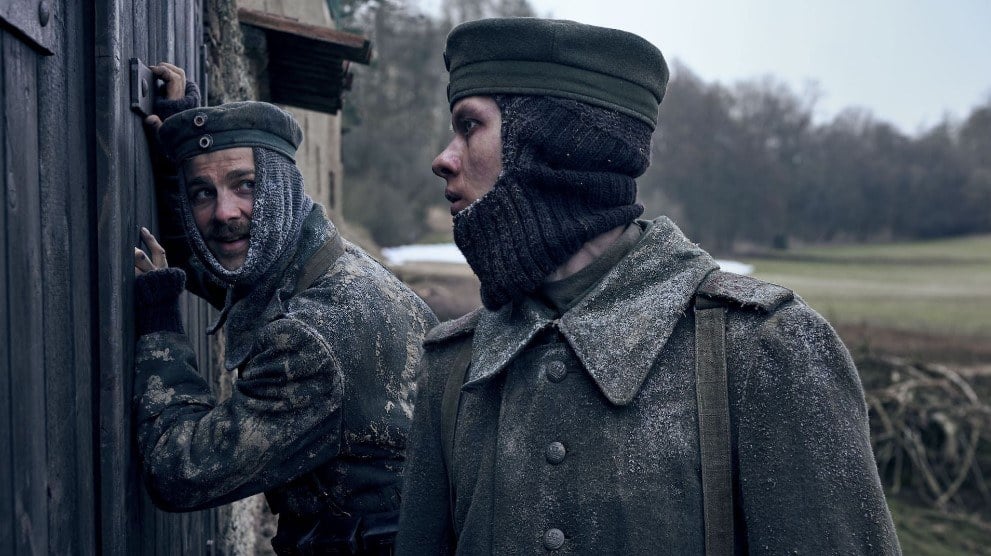
“Sparkle.”
This was the term used by director Edward Berger, cinematographer James Friend, ASC, BSC and colorist Andrew Daniel to describe what they were adding to All Quiet on the Western Front in the finishing process.
Says Friend, “It basically means boosting the highlights and increasing the contrast between the brightest points and the darker shadows, so that everything looks a bit brighter, and adding a bit of color to allow everything to pop.”
Daniel, who serves as senior colorist at Goldcrest Post in London, notes that “sparkle” played a major part in doing justice to All Quiet on the Western Front’s literary and cinematic legacy. “We wanted to push saturation and contrast,” he says. “We wanted it to feel classy and modern, but also timeless — like a movie that existed for years, but is only being discovered now.” To that end, Daniel and the team created a “subtle grain structure to feed throughout.”
Since khaki and green naturally dominate the film’s palette, Daniel punched up other colors for more separation and depth. This included the hue of blood, which flows freely in the tragic tale. “Blood was treated forensically,” he says. “We never wanted it to be just red. Sometimes it was darker in tighter shots, and then we would accentuate and brighten it for wider shots with a lot of movement, as in no-man’s land. In those cases, we wanted to let the pops of red be startling and impactful.”
Daniel created a show LUT he describes as “cooler in the mid-tones and blacks, but low-contrast at the bottom end, so we could blast contrast in the grade if needed. We kept saturation pretty muted to allow latitude later on.
“I like to get our basic ideas down using the LUT as a springboard and build from there,” he continues. “I created an S-curve for the bottom end across day scenes and a separate one for night scenes. It was always about getting the most out of the shot and the scene.”
Daniel employed Blackmagic Design DaVinci Resolve software, which he commends for its color management, its ability to quickly execute paint-outs and re-sizes, and its grain plugin. “We spent a decent amount of time reframing shots to make sure we were getting the full force of explosions and gunfire, as well as impactful performance scenes,” he adds.
He performed the grade over 14 days at the UPP post house in Prague — near where the production shot — with Friend, Berger and seasoned visual-effects supervisor Frank Petzold (Armageddon, Starship Troopers) in attendance. “It was great to have access to all of them and have open discussions,” the colorist says. “It was a collaborative experience where all ideas were on the table.” — Mark Dillon
2.39:1
Cameras | Arri Rental Alexa 65; Arri Alexa Mini LF; Sony Venice;Red Epic Dragon (for VFX plates)
Lenses | Arri Rental Prime DNA, Prime 65 S; Tribe7 Blackwing7; Zeiss Compact Prime; Arri/Fujinon Alura
Friend earned a BSC Award, the BAFTA and the Academy Award for his outstanding work in this film. Subsequent to the publishing ion this article, he participated in this episode of ASC Clubhouse Conversations, interviewed by Erik Messerschmidt, ASC:
You’ll find our complete production story on the 1930 feature adaptation of All Quiet on the Western Front — shot by Arthur Edeson ASC — here.






